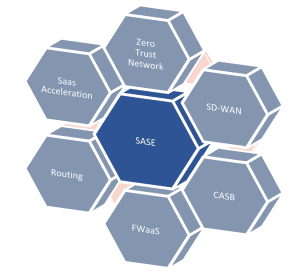
How do secure access service edge (SASE) and zero trust work together to improve network security? Simply put, SASE works by deploying security via the cloud, and zero trust deploys security in the least privileged access method.
Networking trends have heavily shifted in favor of SASE following the shift to remote work. Gartner predicts that 60% of businesses will adopt or begin to adopt a SASE-oriented model for their company by 2025. Let’s discover more about how SASE and zero trust work together to benefit large enterprise networks.
SASE and zero trust defined
The rise of SASE has made it one of the most talked-about terms in the world of networking, but defining it in simple terms has proved challenging for some. Palo Alto Networks defines SASE as a convergence of several protocols into a cloud-based interface, including wide area networking (WAN), cloud access security broker (CASB), firewall as a service (FWaaS), data loss protection (DLP), and zero trust.
SASE uses edge computing to solve the inherent bandwidth issues caused by the in-and-out traffic of proxy connections to SaaS programs via the company data center. SASE allows companies to apply their security measures to these programs, preventing possible security leaks and mitigating them when they do happen.
SASE’s emphasis on applied proxy security is due to zero trust architecture, which has recently gained popularity. Traditional models have used a “castle & moat” approach, installing firewall protection around a business’s network perimeter. These models assume, however, that devices within the network are inherently trustworthy. Zero trust architecture never changes these protocols to make such an assumption, demanding that the user or device provide credentials regardless of circumstance. Learn more about the SASE model’s key use cases and benefits and the zero trust security benefits for large companies.
How SASE and zero trust work together
The new focus on proxy connections is what truly defines both SASE and zero trust. Whereas the company data center used to act as the nerve cluster of business operations, that role has now been fundamentally decentralized and relegated to many smaller data paths coming from remote locations.

2020 saw a rise in cybercrime due to an increased dependency on unprotected (or poorly protected) cloud and remote access programs during the pandemic—the FBI reported a 75% increase in daily cybercrimes by June. This exposed a dire need for protocols that offer security rules. Zero trust architecture provided precisely this opportunity, using SASE’s emphasis on edge computing to issue company protections from proxy locations onto cloud-based services.
However, zero trust security doesn’t just provide multiple checkpoints for potential users in a network; it also restricts user access once checkpoints have been cleared. Think of your enterprise network like a concert—the ticket gets you into the venue, but if you want to access the VIP or backstage areas, you need to clear additional checkpoints with an ID badge or backstage pass. With zero trust security, users and devices only gain access to the specific resources they’ve authenticated to—they’ll need to prove their identity and verify their privileges if they want to move to any other area of your network.
These security protocols are critical to successful SASE implementation, as it allows companies to implement their security protocols for SaaS programs and mitigate potential leaks when they do happen. Together, they provide the best of both worlds, allowing for a decentralized network model that still provides the security needed for such a model to exist. It is precisely this balance between access and safety that makes SASE and zero trust what you need to shield your business as you continue to accommodate remote work and distributed users.
Why does my company need both SASE and zero trust?
A SASE network implementation lacking zero trust principles is left drastically exposed to potential cyberattacks. For example, the lack of internal protection ensures that a more extensive information leak could happen.
Consider what would happen if you implemented SASE without zero trust, and a hacker used a compromised account to connect to one of your cloud applications. In addition to stealing the data available in that cloud app, they could potentially jump to other edge resources using the same username and password, or even find an access point to your primary enterprise network. The more lateral movement that account has on your network, the more sensitive data they could exfiltrate. Additionally, the absence of intensive logs ensures that these leaks will consume a great deal of time and energy as network managers attempt to locate and neutralize threats when they arise.
On the other hand, while it’s never a bad idea to put extra measures in place to secure your data, the purpose of zero trust is to handle edge computing access to cloud-based SaaS applications. Zero trust is a welcome addition to your existing security stack and removes the necessity of having a centralized model.
Talking about SASE and zero trust individually makes the two of them sound as though they are mutually exclusive; they aren’t. Zero trust security is one of many programs integral to the successful implementation of SASE. This listing of the key SASE components gives more context regarding how these systems work together.
Implementing SASE and zero trust protocols
The advantages these two protocols offer companies stem from the way they are used together. When combined, SASE and zero trust allow companies to recenter their business models around a proxy structure. This new model gives employees the flexibility of working from home while ensuring that sensitive information remains safeguarded against ransomware and cyber attacks. Palo Alto Networks cites that the advantages of combining SASE & zero trust are:
- Stronger network security
- Streamlined network management
- Reduced costs of deploying security at scale
- A single, holistic view of the whole network
The final benefit listed above is worth further consideration. Instead of viewing your company’s systems as individual pieces, conversion to the SASE model allows you to view your company’s network through a single lens. This helps to streamline your business model even further, making you that much more competitive in the workplace of tomorrow.
We encourage you to read Gartner’s roadmap for SASE convergence for more information.
Ready to begin your conversion to SASE?
Our products page boasts several options to get you started. Contact us for further questions and get started today!
